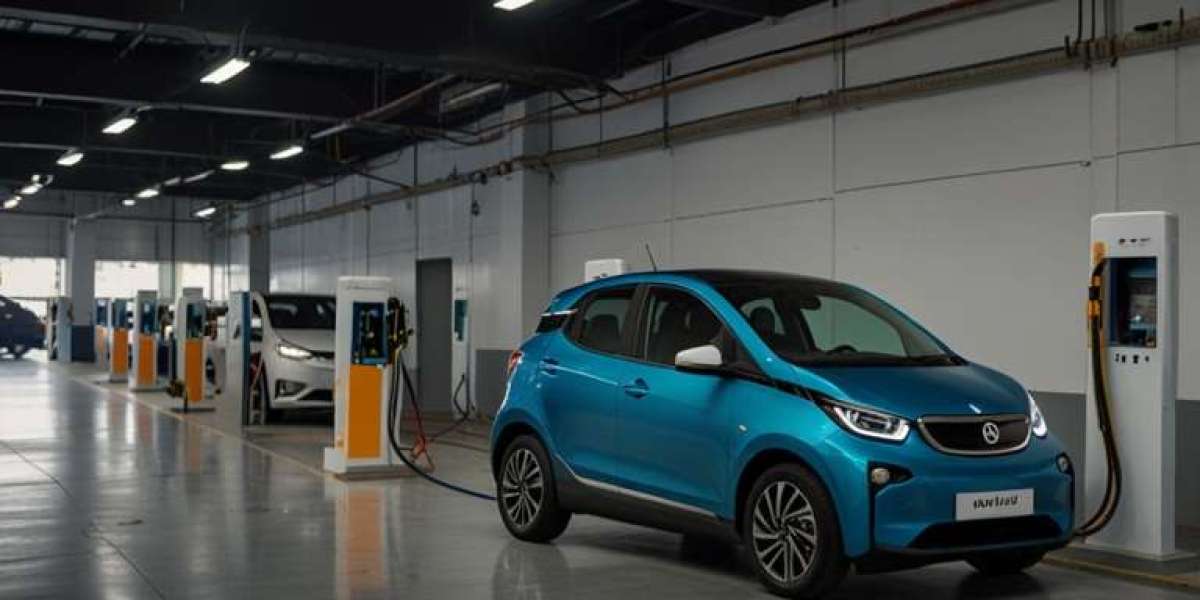The India electric vehicle (EV) market industry is in the midst of a transformative evolution—driven by technological innovation, manufacturing scalability, government policy, and shifting consumer preferences. From electric two-wheelers to high-end EV passenger cars, the “India Electric Vehicle Market – Global Industry Size, Share, Trends, Opportunity, and Forecast, 2020–2030F” report sheds light on emerging patterns that will reshape the Indian mobility ecosystem.
Download Free Sample Report: https://www.techsciresearch.com/sample-report.aspx?cid=1360
Industry Key Highlights
- Market Size & Forecast
In 2024, the India EV market valuation stood at USD 6.16 Billion. By 2030, it is projected to hit USD 10.95 Billion, reflecting a 10.06% CAGR—a testament to sustained demand, tech evolution, and regulatory impetus. - Vertical Integration & Localization
EV value chains in India are becoming increasingly integrated. Automakers, battery firms, and tech companies are developing in-house capacities—from EV platforms and battery systems to telematics, digital fleet management, and predictive maintenance powered by AI. - Cluster Development
Key manufacturing hubs—including Tamil Nadu, Maharashtra, and Gujarat—have emerged as major nodes. These states are not only attracting capital from OEMs and battery firms, but also generating entire ecosystems of battery, motor, controller, and telematics suppliers. - Segment Performance
Electric passenger vehicles (cars) emerged as the fastest-growing segment in 2024. Its ascent owes much to broader consumer adoption, economies of scale, richer feature sets, and the rollout of charging infrastructure. - Regional Growth Patterns
India’s Western states—Maharashtra, Gujarat, Rajasthan—are central to EV adoption, buoyed by strong EV policies, infrastructure expansion, solar-powered charging stations, and solar-expressway linkages. - Stamp of Big Brands
The Indian EV space is dominated by Tata Motors, MG Motor, Mahindra & Mahindra, Hero Electric, Okinawa, JBM Auto, Greaves, Saera, PMI Electro Mobility, YC Electric, among others.
Emerging Trends
1. Digital Fleet Management & Predictive Telematics
EV fleet operators—like app-based taxi services and last-mile logistics providers—are increasingly relying on AI-powered telematics platforms. These platforms use real-time vehicle data to schedule maintenance alerts, reduce downtime, enhance battery performance, and optimize routes.
2. Vehicle-to-Grid (V2G) Technology
India’s power utilities are aligning with EV stakeholders to pilot V2G integration projects. Here, idle EV batteries feed energy back to the grid during peak hours—boosting grid reliability and offering revenue-sharing avenues for EV owners.
3. Novel Battery Chemistry & Manufacturing
Indian-R&D efforts are accelerating efforts to develop indigenous Li-ion formulations—such as LFP and NMC variants—reducing dependence on imports, lowering costs, and enhancing battery longevity.
4. Multi-modal Shared Mobility Models
EV adoption is evolving alongside shared-mobility models—covering cars, cargo EVs, ride-hailing fleets, and intra-city buses. Start-ups and fleet aggregators are moving toward the electrification of entire fleets with smart energy and route planning systems.
5. Expanding EV Charging Infrastructure
State governments lead the charge in deploying public fast chargers along highways and urban hubs. Solar-powered and expressway-installed chargers are reducing consumer range anxiety and establishing confidence in EV usability.
6. Digital Finance, Leasing & Subscription Models
Fintech collaborations and NBFC-led leasing/subscription models are simplifying ownership with flexible down payments, no-ownership options, and integrated digital documentation and insurance.
7. Integration of Renewable Energy
EV manufacturing and charging solutions are increasingly integrated with renewable energy. Battery gigafactories leverage thermal coal and solar energy facilities, reducing carbon footprint and enhancing grid sustainability.
Drivers
1. Environmental Commitments & Emission Norms
India’s regulatory shift toward BS VI+ and COP 21 commitments drives interest in zero-emission vehicles aligned with urban emission reduction goals and climate pledges.
2. Supportive Policy Frameworks
Central and state governments provide incentives—FAME II and additional state subsidies—to reduce vehicle costs, build infrastructure, and promote electrification of shared and public transport fleets.
3. Affordability Through Localization
Localized production of motors, batteries, and associated EV components is driving down costs. Consumer budgets are aligning with EV price brackets across middle-income cohorts.
4. Charging Infrastructure Expansion
An expanding network of highway fast chargers (CS, CCS), battery swap hubs, public chargers, and solar-integrated systems are eliminating urban range limitations.
5. Private Sector Mobility Partnerships
OEMs and fleet operators are embracing EV-first strategies. For instance, ride-hailing platforms are piloting 100% EV fleets, signaling a broader shift.
6. Consumer Aspirations & Lifestyle Shift
Tech-rich features—regenerative braking, connected dashboards, OTA software updates—have moved EVs from niche to aspirational mainstream.
Competitive Analysis
Established OEMs
- Tata Motors: Dominates with competitively priced EV sedan and SUV models (e.g., Nexon EV, Tigor EV), integrated charging networks, and advanced software dashboards.
- MG Motor India: Backed by global know-how and charging tie-ups, MG Electric is gaining traction in the premium hatchback segment.
- Mahindra & Mahindra: Large operational experience and a strong rural distribution network offer them an edge. XUV400 and e-Verito are notable entries.
Pure EV Specialists
- Hero Electric, Okinawa, Greaves: Leaders in two-wheeler EVs, offering convenient battery-swap and finance schemes.
- Saera Electric, YC, PMI: Newer players focusing on three- and four-wheeler EVs with fleet solutions.
Infrastructure & Energy Partners
OEMs are teaming with energy firms and utilities to build fast-charging zones, V2G pilots, and integrated EV ecosystems.
Battery Value Chain Players
Newer firms are enhancing production of Li-ion cells, battery management systems, and seeking global partnerships to localize high-end cell manufacturing.
Strengths, Weaknesses & Market Responses
- India’s advantage: Increasing EV affordability, expanding charging infrastructure, and tech-rich vehicles with bespoke local solutions.
- Challenges: High initial costs, limited premium models, rarefied supply of fast-charging stations in smaller towns, raw material import reliance.
- Market responses: Owners choose hybrids temporarily; OEMs partner with banks for EV loans; state subsidies fill infrastructure gaps.
Future Outlook
Ten-Year Landscape (2025–2030)
- Market Growth Trajectory
Expect the EV market to grow past USD 10.95 B by 2030, driven by aggressive target alignment, infrastructure rollout, and price parity with ICE vehicles. - Commercial Fleet Adoption
Street logistics (electric cargo bikes, EV Zeus vans), municipal fleets, last-mile vehicles, and expressway coaches will all accelerate electrification, particularly with V2G-enabled piloting. - Battery Manufacturing Deepening
Battery gigafactory rollouts, cell-formula indigenization, recycling mandates, and second-life battery reuse in grid storage will sharpen India’s competitive edge. - Tier-II & Tier-III Surface
EV adoption will spill into tier-2 and 3 cities as charging infrastructure spreads and lower-cost options emerge. - Technology Upgrade & Connected EV Ecosystems
OTA updates, battery-as-a-service models, and EV-integrated mobility apps will grow. EVs may also emerge as smart-home/stationary storage units. - Policy Evolution
Future regulations may include single-point zero emission zones, new battery disposal laws, updated import duties, or OEM mandates for electrification.
10 Benefits of the Research Report
- Quantified Growth Forecast
Clear projections (USD 6.16 B in 2024 → 10.95 B in 2030) empower internal budgeting and strategic planning. - Segment-Specific Insights
Breakdown by EV range, propulsion type, and vehicle segment allows precisely targeted development. - Regional Opportunity Mapping
Geographic hotspots (West India, Tamil Nadu clusters) help OEMs and investors localize market entry. - Competitive Intelligence
SWOT-style analysis across OEMs and infra companies reveals competitive positioning and partner opportunities. - Technology Adoption Trends
Highlights in predictive maintenance, V2G, battery chemistries, and telematics guide R&D investments. - Policy & Incentive Landscape
Aggregate government measures (FAME II subsidies, tax benefits, infrastructure rebates) give a strategic edge to stakeholders. - Charging Infrastructure Data
Coverage gaps, charging load forecasts, and utility-run pilot maps inform infrastructure planning and investment. - Supply Chain Readiness
Maps out manufacturing clusters, component ecosystems, and inward investment flows to support localization. - Market Entry Barriers
Price delta and infrastructure gaps inform partnership needs (e.g., financing partners, leasing platforms). - Stakeholder Guidelines
Tailored insight for OEMs, EV component makers, battery firms, utilities, and fleet owners.
Competitive Analysis (Deeper Dive)
- Tata Motors
- Strengths: Product depth; established dealership; South Asia reach.
- Weaknesses: Premium EV segment just entering; fast-charging synergy limited.
- Strategy: Partnerships with BPCL & Tesla-style battery-integrated vehicles.
- MG Motor India
- Strengths: Strong design appeal, UK tech linkages.
- Weaknesses: High consumer pricing barrier; scale still limited.
- Strategy: Tie-ups with infrastructure and premium brand-building.
- Mahindra & Mahindra
- Strengths: Rural penetration; utility vehicle dominance.
- Weaknesses: Lagging behind in feature-rich EVs.
- Strategy: Introduce EV versions of XUV, Bolero; electrify commercial transport.
- Hero Electric / Okinawa / Greaves
- Strengths: Brand recall among urban commuters; battery-swap tie-ups.
- Weaknesses: Limited models for higher spenders.
- Strategy: Expand into cargo, subscription models, connectivity.
- Start-ups & Fleet EVs
- Strengths: Agile innovation; fintech integrations.
- Weaknesses: Operational flattening; capital constraints.
- Strategy: Niche fleet tie-ups; B2B platforms; white-label solutions.
- Battery & Component Firms
- Strengths: Early-stage tech adoption; futuristic partnerships.
- Weaknesses: Tech costs; licensing complexities.
- Strategy: JV with Chinese/Global firms; integrate across energy sectors.
- Charging & Energy Providers
- Strengths: Supply chain integration; utility leverage.
- Weaknesses: ROI unproven in less-used highways.
- Strategy: Integrated energy + EV platforms (e.g., solar-charging hubs).
Future Outlook (Extended Perspective)
Household & Ownership Cost Parity
By 2030, with battery costs falling below USD 100 /kWh, EVs may achieve total cost of ownership parity with ICE vehicles—even before subsidies.
Integrated Battery-as-a-Service (BaaS)
Annual battery-subscription models will reduce up-front costs, enhance battery recycling, and optimize lifecycle value.
EVs as Energy Storage Systems
EVs may tap into grid services, especially as V2G becomes broadly adopted among fleet-owners or municipalities, enabling net-zero CO₂ goals.
Multi-Modal EV Ecosystems
“Last-mile” EV buses, solar-EV fleets, and energy-managed EV ecosystems will redefine urban mobility patterns.
OEM Partnerships Beyond India
India-made EVs could gain global traction, especially in Latin America and Southeast Asia, due to cost-competitiveness and shared-market dynamics.
Autonomous EV Pilots
With rolled-out telematics and OTA infrastructure, autonomous/navigational EV pilot projects may emerge by end-decade—with ride-hailing and logistics tie-ins.
Contact Us-
Mr. Ken Mathews
708 Third Avenue,
Manhattan, NY,
New York – 10017
Tel: +1-646-360-1656
Email: [email protected]
Website: www.techsciresearch.com



